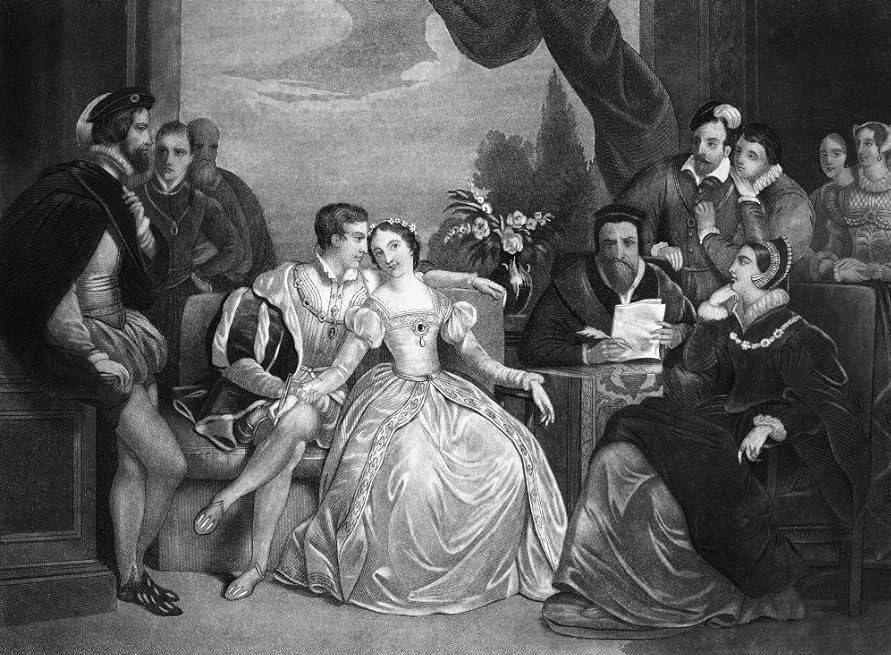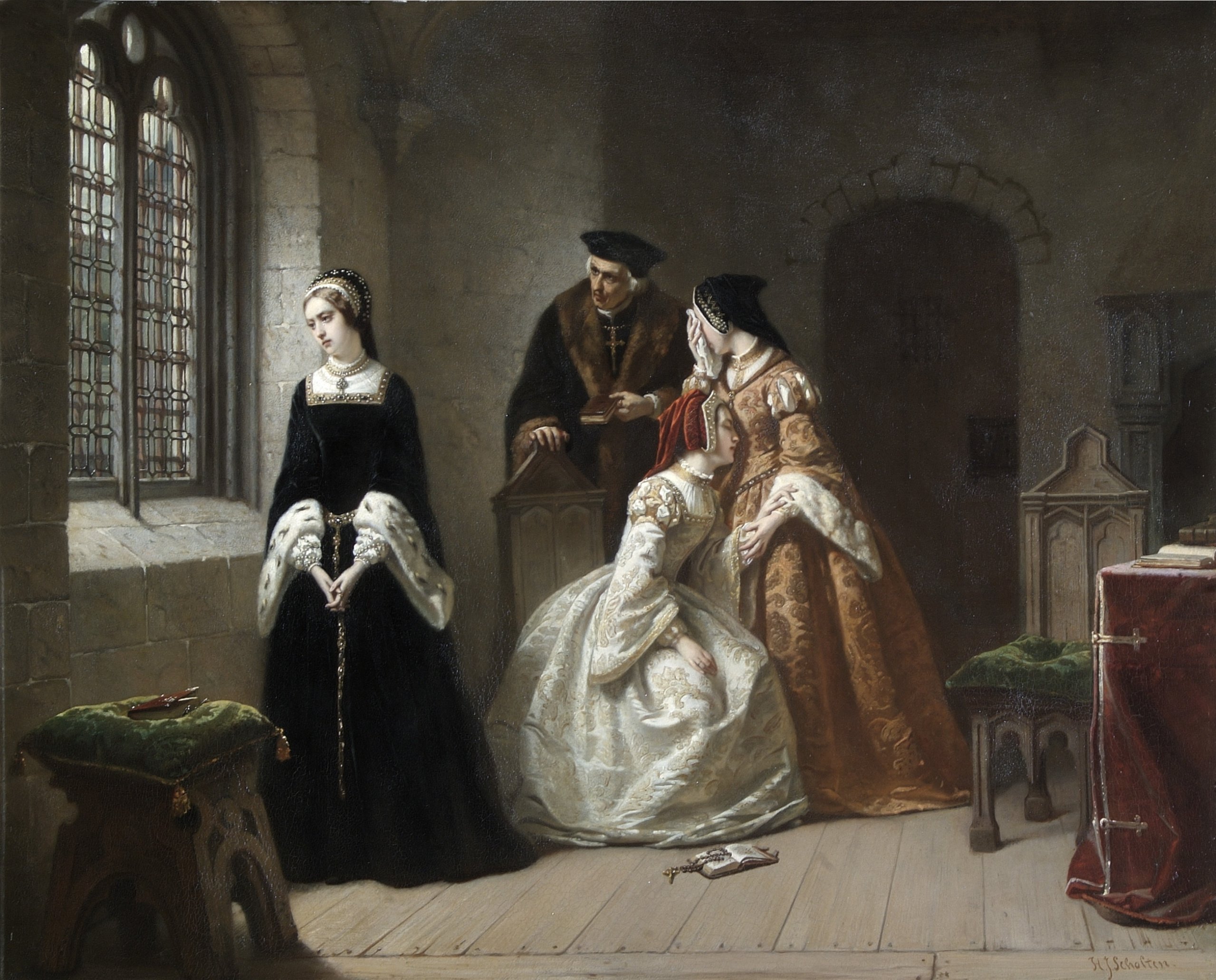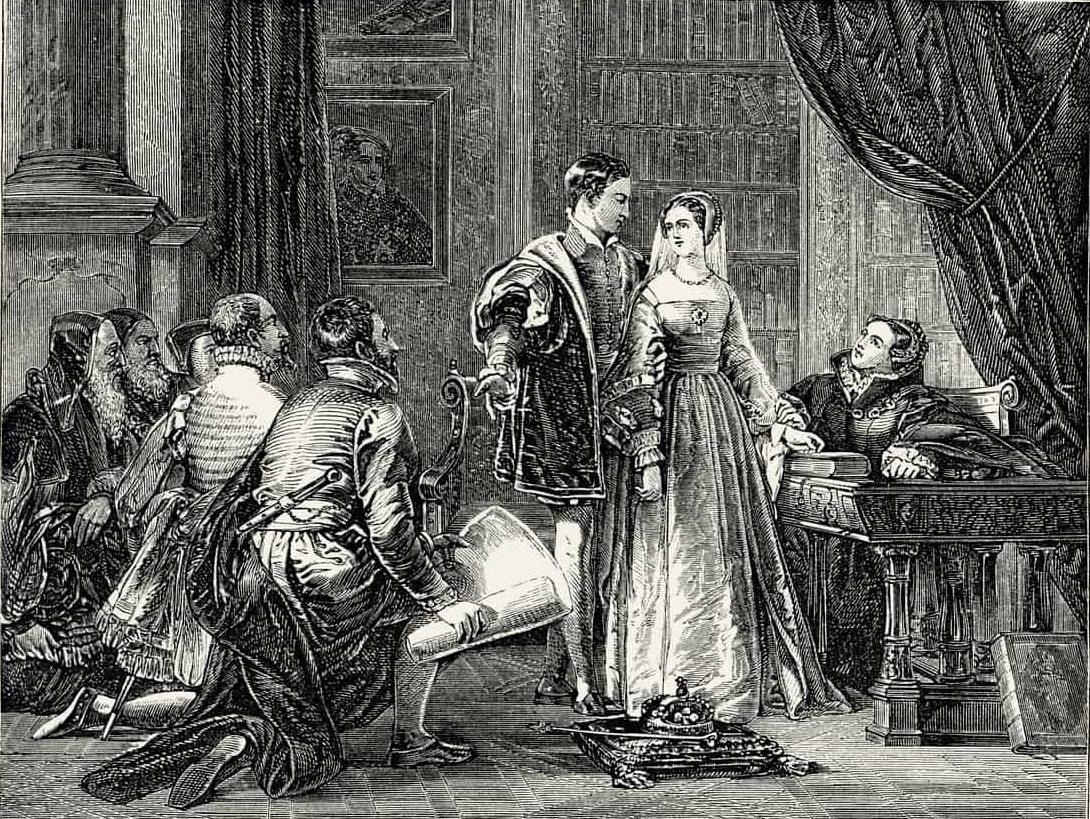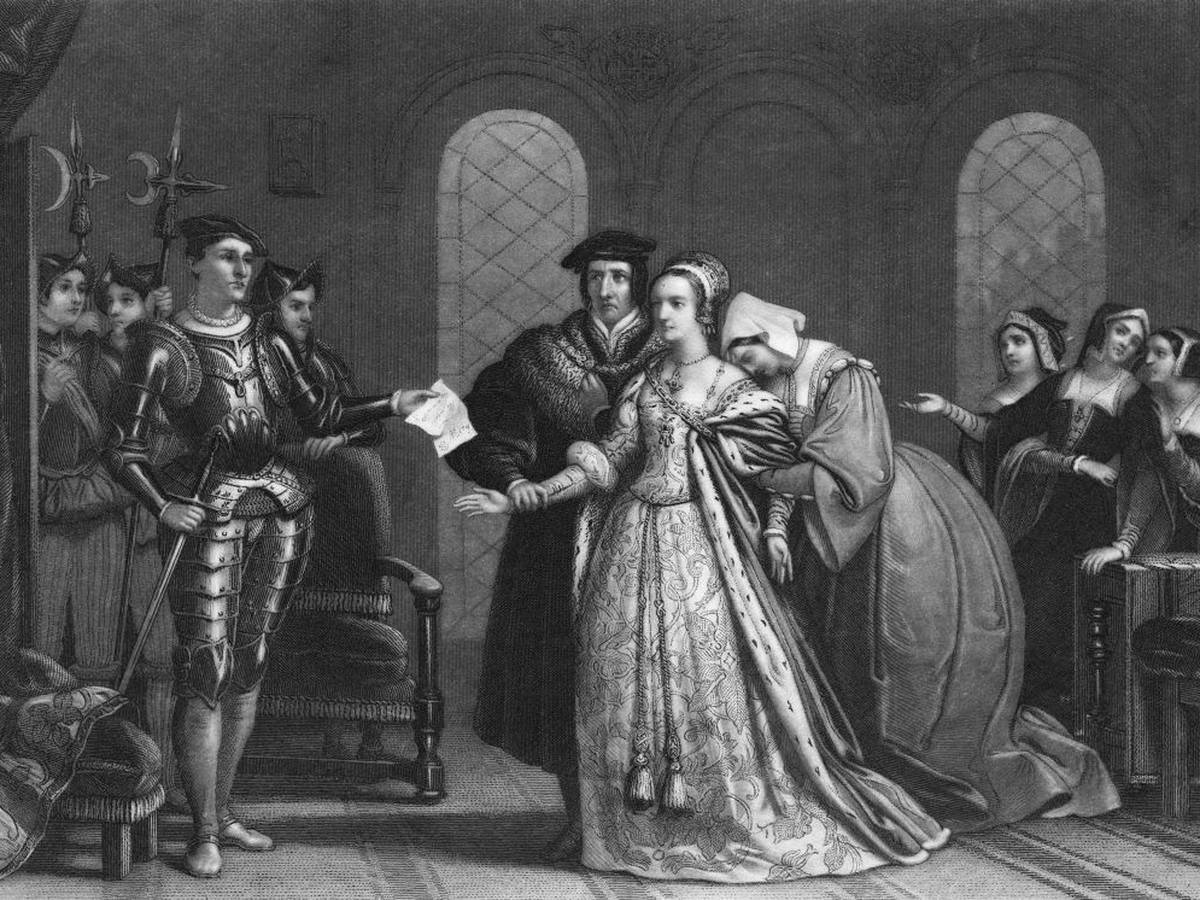Lady Jane Grey is most well known for her nine-day stint as queen – the shortest reign of any British monarch. It was so short, that there is some question over whether she is actually to be counted among rulers of England. Her execution shortly afterwards, when she was still only sixteen years old, means there really isn’t much else for her to be known for. Her claim to the throne came through her mother, a granddaughter of Henry VII through his daughter Mary Tudor, Queen of France. What is lesser known is that Jane was one of three children with such a claim. She had two sisters, Katherine and Mary, both of whom were in the vague running to be successors to their cousin Queen Elizabeth I.
The Grey sisters were among the most eligible heiresses in England. Through their mother, Frances Brandon, they had royal blood. Their father, Henry Grey, was Marquess of Dorset in his own right and had been granted the Dukedom of Suffolk on his wife’s behalf after the death of her brothers. Both parents were frequently at court and popular which meant, in theory, that their girls were all set to make good and advantageous marriages. In reality, the Grey girls would not live out the comfortable lives they were promised on paper. And while two of them married for love, not one of the sisters had what could have been considered a happy marriage. Jane’s marriage was not the great romance presented in My Lady Jane.
Jane and Guilford: A Match Made on Paper
The choice of husband for Lady Jane Grey began with John Dudley, Duke of Northumberland. A competent soldier and general under Henry VIII, Dudley came into his own during the minority of Edward VI. Initially part of the regency council, Dudley ousted the leader of the council and Lord Protector, Edward Seymour, and took control for himself. He consolidated his position as the most powerful man in the country but this would only be true so long as Edward VI was king. As the man closest to the king, Dudley was one of the very few in the realm who knew that Edward was not going to be king for long.
By 1553, fifteen year old Edward VI was increasingly unwell. His public appearances were often cancelled due to illness and it was becoming clear to his doctors that he was unlikely to recover. This was of course kept secret from the wider court and nobody beyond Dudley and his immediate supporters were aware of the fact. Another fact that Dudley was achingly aware of was how his power was inevitably tied up with that of the young king. Without Edward, Dudley had nothing. Under the terms of Henry VIII’s will, should Edward die without issue, the throne of England would pass to the young king’s elder sister, Mary which was the last thing Dudley wanted. He was politically and religiously opposed to Mary and if she became queen then the best he could hope for was complete and total political exile. It was far more likely that she would find a pretext upon which to have him executed. The only way he could maintain his level of power and control over the throne was if he controlled who sat upon it.
Dudley embarked upon a strategy of marriages that aligned his family with the most prominent nobles in the land and the coup de grace was the union of his son Guildford with Lady Jane Grey. He must have entertained the idea of marrying Guildford to the young Princess Elizabeth but anybody who had even a passing knowledge of the Princess knew that she would never be compelled to do anything, not even by a husband. Elizabeth would absolutely not be controlled. Besides, if the succession were to be diverted away from the daughters of Henry VIII, it would be easier to disinherit both rather than just one.

Jane’s relationship with her parents was tumultuous, to say the least. She notoriously didn’t like them and they were known for their constant arguments. Still, Jane and her parents were in complete agreement on the matter of her marriage; not one of them wanted Guildford Dudley for Jane’s husband. Her mother believed that she was too young for marriage and both Grey parents hated the Dudleys. Jane’s mother and Guildford’s mother particularly detested each other. But Dudley browbeat the Greys into accepting the marriage and in turn, they beat their daughter. Literally.
Guildford Dudley was seventeen years old and the youngest of his parents’ seven surviving children; the undoubted favourite of his mother. He was a handsome but incredibly spoiled boy, and arrogant as a result. His personal qualities, however negative, likely had little impact on Jane’s decision. She was an intelligent girl and it would have been a stretch that she didn’t grasp the political implications of the very many marriages being made around hers.
Convention required that a couple about to be married were polite to each other. Love matches were rare and couples weren’t always devoted or affectionate in public, but they were at least expected to be civil. Lady Jane Grey was not happy about her marriage and she was not prepared to be civil about it. One contemporary remarked that there had been no more political marriage in history, with neither party showing the slightest interest in each other. There are also stories that Jane spent the days leading up to her wedding sporting bruises and a black eye but I couldn’t find a contemporary source to substantiate it. Her parents were known to beat her badly and contemporary sources do prove that they did in the leadup to her marriage, but it isn’t likely that they would have made a spectacle of her when she was going to be so visible in the coming weeks.
Three Weddings and a Sick King
On the 21st May 1553, Whit Sunday, Lady Jane Grey married Guildford Dudley. She was one of three brides at the triple wedding which saw her younger sister, Katherine, marry the young Henry, Lord Herbert. Guildford’s sister, another Katherine, was also married to another Henry, this one Henry Hastings, heir to the Earldom of Huntingdon.
The wedding was a grand affair with a guest list of the most prominent nobles of the land and foreign ambassadors to pay their respects to the king’s much-loved cousin. There were however some notable absences. Neither of the Tudor princesses had been invited and the king was missing. Despite his best efforts to muster, he was simply too ill on the day and couldn’t rise from his bed. There were masques, jousts, and feasting to celebrate the day and those present couldn’t have missed the signal the event gave. Mary and Elizabeth were missing, the king was ill, and the bridal party were celebrating with gusto. They were even decked out in jewels and fabrics taken from the king’s wardrobe. While it might have been obvious to everyone that the succession was going to be diverted, for Dudley it was a done deal. He was the only person present who knew that the ailing king had drafted a ‘devise for the succession’ which excluded his sisters and instead gave Jane, and her future male heirs by Guildford, the throne.
That night, the three brides and their husbands returned to their father-in-law’s respective houses where for Jane at least the marriage was probably consummated. We can assume that Jane and Guildford didn’t fall madly in love with each other overnight as the following morning they both left for separate houses. Jane returned to her parents and Guildford to his mother where they apparently had little to do with each other.
After six weeks of this, the king was much worse and it became clear to Dudley that he was not going to recover. Dudley’s wife, the Duchess of Northumberland, went to the Grey house and caused a scene, demanding that Jane return to her husband’s side. She acquiesced but managed only two days in their company before she suffered an attack of nervous strain. The Duchess sent her to Chelsea Manor, the house in which Jane had grown up as Queen Catherine Parr’s ward, to recuperate. She did however insist that Guildford go with her.
Their time at Chelsea hardly proved to be a bonding experience. A few courtiers went with them to make up the party but an accident in the kitchen led to large-scale food poisoning putting everyone in bed. Jane insisted that the Duchess of Northumberland had been responsible and was trying to remove the daughter-in-law she found so disagreeable. In reality, the Duchess would have been all too aware of how her power hinged on Jane’s health however disagreeable the two women found each other.
The Nine-Day Queen
Shortly after the incident at Chelsea, John Dudley’s plans came to fruition. On the 6th July 1553, Edward VI died and Dudley moved to secure the throne. Over the next couple of days, he suppressed the news and began mobilising forces to capture Mary Tudor before she could rally her supporters. Three days later, he declared Jane Queen of England.
I have already written in detail about Jane’s brief reign but suffice to say Jane was not enthusiastic about her elevation. Some sources have her bursting into tears as Dudley read the proclamation and crying that she was unworthy of the throne. Guildford on the other hand was enjoying his sudden elevation to king-in-waiting and is described as preening around the court in a new wardrobe.
Jane and Guildford were moved to the Tower of London in preparation for her coronation. There are conflicting stories of their journey. On one hand, Guildford is described as being affectionate and attentive towards his wife in the barge that conveyed them down the Thames. Other stories have him simply walking beside her, cap in hand, looking a little sullen. When the two arrived, they were taken to separate apartments.
The following day, Jane was fitted for her crown. The Lord Treasurer saw that she was struggling with the enormity of the task and tried to reassure her that whatever crown she chose, another would be made for her husband. It was the wrong thing to say. Jane flew into a rage screaming that her husband would never be made king by her hand. She would consent to creating him a duke and no more. Guildford heard the shouting and immediately decided to confront his wife. But first, he ran to fetch his mother.
The Duchess of Northumberland descended upon her daughter-in-law in a fury and a screaming match ensued. Jane was under no illusions as to why she had been married to Guildford and why the Dudleys were so invested in her. They had used her to take the throne but she was absolutely not about to hand her power over to their son. In return, the Duchess called her ungrateful and unnatural, while Guildford complained that he didn’t want to be a duke, he wanted to be a king.
Jane refused to budge which prompted the Duchess to storm from the room, Guildford in tow. She loudly proclaimed that they would remove themselves to their house at Syon and that Guildford would no longer wait upon his [insert many expletives here] of a wife. Jane allowed them to leave the room but she did not allow them to leave the Tower. She instructed the Earls of Arundel and Pembroke to hold her husband and his mother and return them to their rooms. Once there, Guildford was told that he was not to leave Jane’s side. Jane was hardly keeping him there for his good company; she was simply not prepared to allow the Duchess or her husband to snub her so publicly. If she was to be queen then she could not be seen to have discord within her own house. So the couple remained in the Tower albeit on opposite sides of the palace. Guildford was more sullen than he had ever been and Jane wrote bitterly about his treatment of her.
Just a few days later, Dudley’s schemes had come to nought. The Privy Council had revoked their support of Jane and thrown their weight behind Mary who had won the throne in her own right. To huge public acclaim, Mary was proclaimed Queen of England. Conveniently, Jane was already in the Tower of London so there was no need to move her or her husband. Jane and the Dudleys were found guilty of high treason and sentenced to death but only John Dudley was immediately led to the block.
The Last Six Months
The Dudleys remained in their rooms as a family while Jane was housed elsewhere. Although a prisoner under a charge of treason, it was well known that Mary didn’t want to punish her cousin for Dudley’s schemes, and Jane was attended to by a small household. While in the Tower, Jane focused on her studies and showed little interest in anything that wasn’t scriptural. She didn’t ask for her husband.
In mid-September, the imprisoned Dudley men were given permission to see their wives. The offer was not extended to Guildford but he doesn’t seem to have protested or written to the Privy Council demanding the same. The name ‘Jane’ was found carved into the wall of the room where Guildford was being held and while some romantics have suggested that it was a sign of his devotion to his wife, there’s no evidence to say it was there by his hand. He shared the room with his brothers and their mother’s name was also Jane. Given how little time they spent together and how little regard they had for each other when they did, it’s doubtful that Guildford missed Jane so much that he was driven to carve her name in stone.
As a prisoner in the Tower, Jane was an inconvenience and she would have remained so until the new year when a rebellion launched with the intent of overthrowing Mary in favour of Jane. Mary had gone out of her way to preserve her cousin’s life but the rebellion showed that there were those who would prefer Jane on the throne. Jane’s life therefore put Mary’s reign in jeopardy and with no other option presented to her, Mary went ahead and signed the death warrants for Jane and Guildford.
Jane’s father was also sentenced to death for his role in the rebellion and when he was brought to the Tower we see a rare moment of affection in Jane and Guildford’s marriage. It wasn’t directed towards each other though. Instead, Guildford sent a prayer book to his father-in-law via his wife and included a brief note signed ‘your humble son to his death.’ Jane added a similar note and the book was duly delivered to Lord Grey.

Both Jane and Guildford were scheduled to die on the 12th February 1554. The day before, Guildford sent a message to Jane requesting to see her before they were taken to the scaffold. Jane refused. She said that the two of them had spent the night preparing their souls and shouldn’t weaken their resolve by seeing each other now. Besides, they would be united in heaven soon enough. Guildford was taken to Tower Hill to be executed in public. Jane watched him leave and his body return but beyond a remark on the bitterness of death, she didn’t react. They had been married for a little over ten months.
Jane was taken out to Tower Green, the private place of execution, where she gave a conventionally short speech declaring her support for the queen and asking those gathered to pray for her. She commended her soul to God and after some brief fumbling where she lost grip on the block, she lay down her head for the last time.
It’s safe to say that the marriage of Jane Grey and Guildford Dudley, as short as it was, was not a success. After their wedding, they spent at most a fortnight in each other’s company. Though we could attribute some of that to their imprisonment, they repeatedly turned down the offer to see each other and made no attempts to when they were at liberty. To say that Jane had no interest in her husband suggests neutrality when it’s clear that she leaned towards hostility. She didn’t like him or his family and she was known for her obstinance. She had been manhandled into a marriage she didn’t want and it is highly unlikely that she would ever have given Guildford a chance, whether he deserved one or not. If they hadn’t been executed then it’s probable that their marriage would have continued as it had begun; distantly and with a great deal of enmity.
The remains of Jane and Guildford were taken to the church of St Peter ad Vincula to be laid to rest with the other famous executions. Their heads were thrown into the same pit and the rest of them placed near former queens Anne Boleyn and Katherine Howard. Guildford was as close to royalty in death as he had been in life.
Coming soon: the unhappy marriages of Jane’s sisters, Katherine and Mary. Until then you can join me behind the scenes to discover the first victim of Jane’s reign and other historical tidbits at my Patreon.














